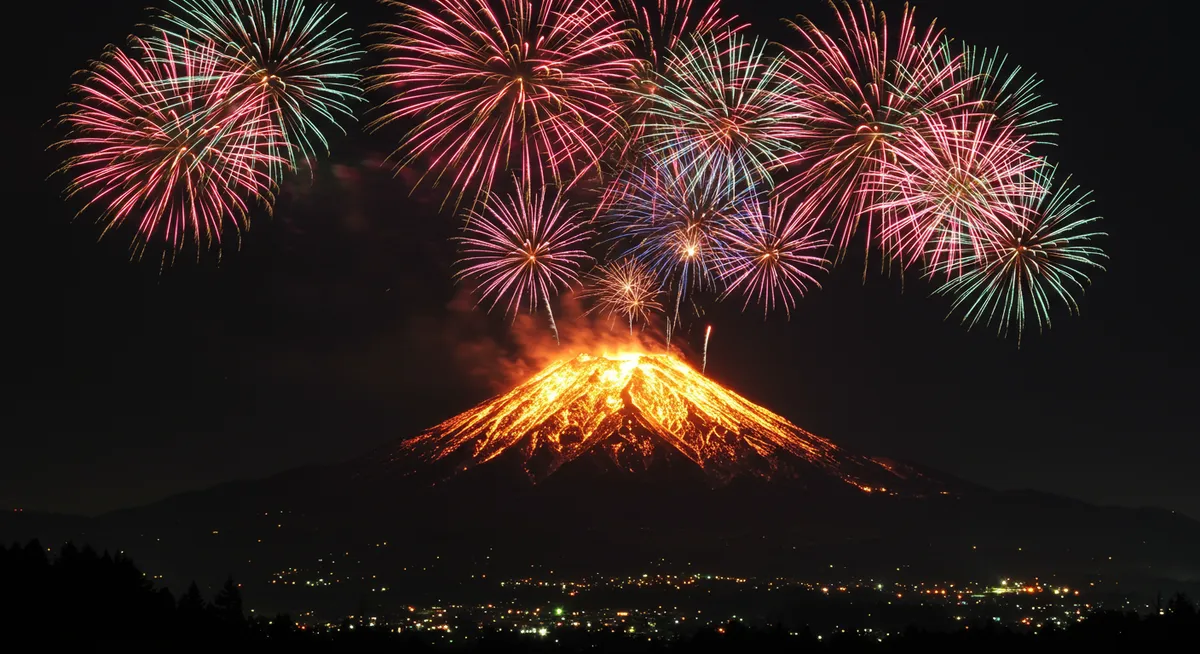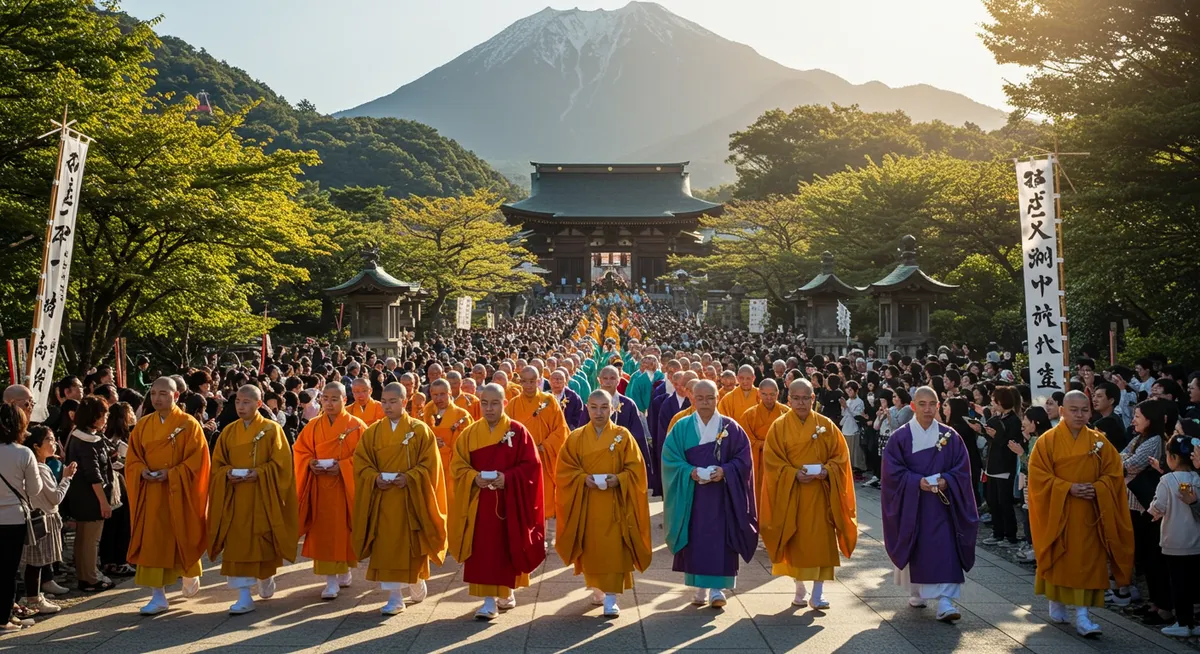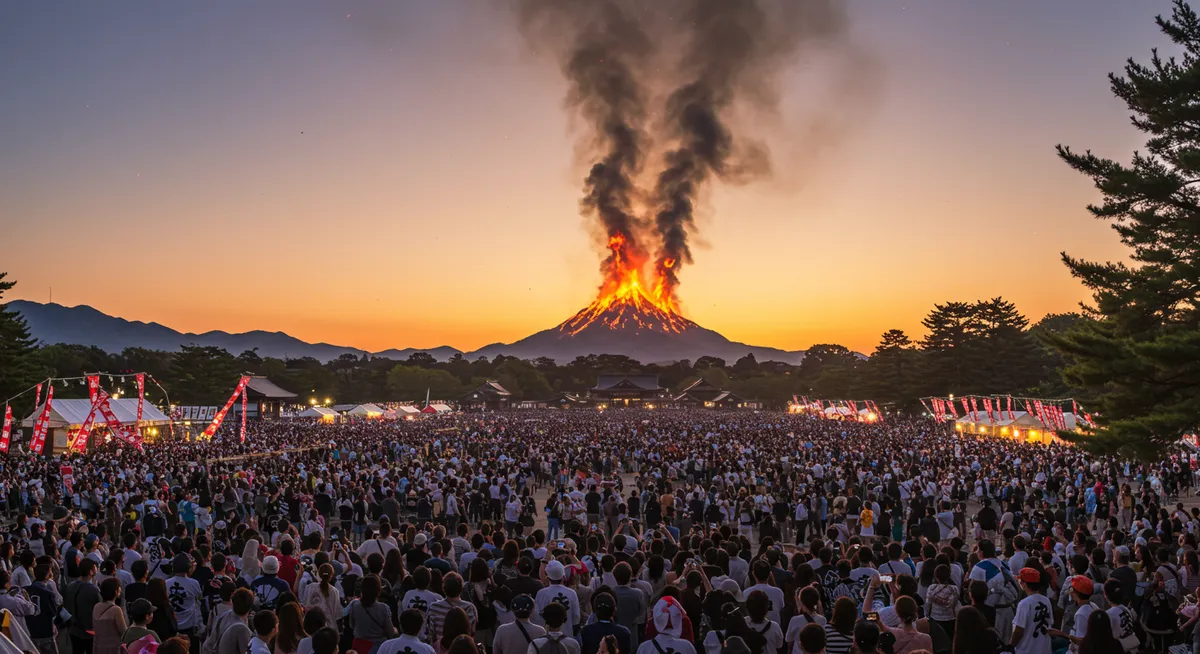Wakakusa Yamayaki: Japan's Ancient Mountain Burning Festival | Nara

Wakakusa Yamayaki: Japan's Dramatic Mountain Burning Festival
As darkness falls over the ancient Japanese city of Nara on a winter evening each January, an extraordinary spectacle unfolds that has captivated visitors for centuries. The entire side of Mount Wakakusa erupts into flames, illuminating the night sky in a controlled but dramatic conflagration that marks the annual Wakakusa Yamayaki Festival (若草山焼き). This remarkable ritual of ceremonial mountain burning combines primal fire symbolism with refined Japanese cultural elements, creating one of the country's most visually stunning and historically intriguing celebrations. For travelers seeking authentic cultural experiences, few Japanese festivals offer such a perfect blend of natural spectacle, historical significance, and cultural immersion.

Origins and History
The origins of this unusual fire festival are shrouded in historical ambiguity, with several competing theories:
- Boundary Dispute Resolution: The most commonly cited origin suggests the burning began as the dramatic conclusion to a boundary dispute between Nara's two major temples, Tōdai-ji and Kōfuku-ji, in the 18th century
- Pest Control Method: Another theory proposes the practical purpose of driving away wild boars and other wildlife that threatened the surrounding villages and temples
- Ancient Fire Ritual: Some scholars connect the practice to prehistoric Japanese agricultural fire rituals intended to appease mountain deities
- Military Signal Use: Historical records suggest the mountain may have been used as a signal fire location during periods of conflict
Historical Context
Understanding Nara's significance enhances appreciation of the festival:
- Ancient Capital: Nara served as Japan's first permanent capital (710-794 CE), establishing the region's historical importance
- Buddhist Center: The city contains some of Japan's oldest and most significant Buddhist temples, eight of which are UNESCO World Heritage sites
- Sacred Landscape: The mountains surrounding Nara have been considered sacred since prehistoric times
- Cultural Continuity: The festival represents one of Japan's unbroken traditions connecting modern practices to ancient beliefs
Festival Timeline and Events
The Wakakusa Yamayaki unfolds through a carefully orchestrated sequence of events:
Pre-Festival Preparations
Before the dramatic burning, significant preparations take place:
- Mountain Grass Management: Throughout the year, grass on Mount Wakakusa is carefully maintained to ensure proper burning conditions
- Firebreak Creation: Safety measures include creating firebreaks to prevent uncontrolled spreading
- Ritual Preparations: Buddhist monks from the local temples prepare sacred objects and ceremonial items
- Community Involvement: Local organizations coordinate various aspects of the festival, from safety planning to cultural performances
Festival Day Ceremonies
The day of the burning follows a traditional sequence:
- Shinto Blessing: The day begins with a purification ceremony conducted by Shinto priests at the base of the mountain
- Procession: Representatives from Nara's major temples, including monks from Tōdai-ji, Kōfuku-ji, and Kasuga Taisha, lead a ceremonial procession
- Afternoon Activities: Cultural performances, traditional music, and food stalls entertain visitors throughout the afternoon
- Ceremonial Archery: A demonstration of yabusame (horseback archery) is sometimes included in the proceedings

The Burning Ceremony
As evening approaches, the main event unfolds:
- Fireworks Display: At approximately 6:00 PM, a spectacular fireworks show signals the beginning of the main ceremony
- Torch Lighting: Representatives from the temples light ceremonial torches from a sacred flame
- Fire Setting: The torches are carried to designated points on the mountain's perimeter to ignite the dried grass
- Mountain Ablaze: Within minutes, the entire 342-meter mountain is engulfed in flames, creating a mesmerizing spectacle visible throughout the city
- Burning Duration: The mountain typically burns for about 30 minutes to an hour, depending on weather conditions
Post-Burning Celebrations
After the main burning subsides:
- Community Gatherings: Locals and visitors alike gather at food stalls and temporary venues around the mountain
- Traditional Performances: Music, dance, and sometimes theatrical performances continue into the evening
- Winter Foods: Seasonal specialties including hot amazake (sweet fermented rice drink), oden (winter hotpot), and grilled foods are enjoyed
- Bonfire Gatherings: Smaller communal bonfires often provide warmth for continuing celebrations
Cultural and Spiritual Significance
Beyond the spectacular visuals, the festival holds deeper meanings:
Symbolic Interpretations
Fire plays multiple symbolic roles in Japanese tradition:
- Purification: Fire as a cleansing agent, burning away the old year's impurities
- Renewal: The burning grass stimulates new spring growth, symbolizing rebirth and regeneration
- Spiritual Communication: Smoke rising to the heavens traditionally serves as a medium of communication with deities
- Community Bonding: Gathering around fire represents the unification of the community in shared ritual
Religious Connections
The festival reflects Japan's intertwined religious traditions:
- Buddhist Elements: The involvement of Buddhist temples connects to concepts of impermanence and transformation
- Shinto Aspects: Purification rituals and nature reverence reflect Japan's indigenous Shinto beliefs
- Agricultural Heritage: The timing near the beginning of the agricultural calendar connects to farming traditions
- Mountain Worship: Reflects the Japanese tradition of sacred mountains (yama-no-kami) as dwelling places of deities
Experiencing Wakakusa Yamayaki as a Visitor
For travelers seeking to witness this remarkable festival, practical considerations enhance the experience:
Practical Information
Essential details for planning your visit:
- Festival Date: Typically held on the fourth Saturday of January, though occasionally rescheduled due to weather conditions
- Location: Mount Wakakusa (Wakakusayama) in Nara, Japan, adjacent to Nara Park and near the major temples
- Timing: Ceremonies begin in the afternoon, with burning usually starting around 6:00 PM after the fireworks display
- Weather Contingency: The event may be postponed if conditions are unsuitable (heavy rain, strong winds, or snow)
Viewing Recommendations
Optimal ways to experience the burning:
- Nara Park: The spacious area at the base of the mountain offers good views and festival atmosphere
- Viewing Area Tickets: Special reserved seating areas closest to the mountain can be purchased in advance
- Elevated Locations: The second floor of the Nara Prefecture Office or restaurants with mountain views offer comfortable alternatives
- Distance Viewing: Even from several kilometers away, the burning mountain creates a spectacular sight

Travel Tips
Enhancing your festival experience:
- Accommodation Planning: Book accommodations in Nara well in advance, as the festival draws significant crowds
- Warm Clothing: January evenings in Nara can be quite cold, so dress in warm layers
- Transportation: Public transportation becomes crowded; arrive early or consider staying within walking distance
- Deer Interaction: Nara's famous sacred deer roam freely throughout the park area; purchase special deer crackers to feed them
- Photography Tips: A tripod is recommended for capturing the burning mountain and fireworks in low light
Complementary Experiences
While in Nara for the festival, other cultural attractions enhance your visit:
- Tōdai-ji Temple: Home to Japan's largest bronze Buddha statue, housed in the world's largest wooden building
- Kasuga Taisha Shrine: Famous for its thousands of stone and bronze lanterns, which are illuminated during special festivals
- Nara National Museum: Houses important Buddhist art and artifacts, with special exhibitions during winter
- Naramachi: The preserved traditional merchant district offers glimpses into old Japan and excellent craft shopping
Ecological and Modern Perspectives
Contemporary considerations have influenced the festival's practice:
Environmental Management
Modern approaches balance tradition with conservation:
- Controlled Burning: The ritual is now carefully managed by fire safety officials to minimize environmental impact
- Ecological Benefits: The burning actually helps maintain the grassland ecosystem that would otherwise transition to forest
- Wildlife Consideration: Measures are taken to ensure local wildlife can safely relocate before the burning
- Regeneration Monitoring: Scientific studies track the mountain's recovery and the effects of annual burning on biodiversity
Cultural Preservation
The festival represents important heritage preservation efforts:
- Living Tradition: One of Japan's continuously practiced fire rituals, maintaining cultural knowledge across generations
- Tourism Balance: Organizers work to preserve authentic ceremonial aspects while accommodating growing tourist interest
- Documentation Efforts: Significant work to record the festival's practices, variations, and historical development
- Educational Component: Increased focus on teaching visitors and younger Japanese about the festival's cultural significance
Plan your Wakakusa Yamayaki experience
For the optimal viewing experience, arrive at Nara Park in the early afternoon to enjoy the preliminary activities and secure a good viewing position before crowds gather for the evening burning ceremony.
Consider planning a two-day stay in Nara to explore the city's magnificent temples and shrines before or after attending this unforgettable fire festival.
Explore More Asian Cultural Festivals
If you're fascinated by Wakakusa Yamayaki, discover other extraordinary Asian celebrations that showcase the continent's rich cultural heritage:
Harbin Ice Festival
China's spectacular winter celebration featuring enormous illuminated ice architecture and snow sculptures.
Sapporo Snow Festival
Japan's famous winter event with monumental snow sculptures and winter activities.
Gion Matsuri
Kyoto's magnificent month-long festival with elaborate float processions and traditional arts.
Nyepi
Bali's extraordinary Day of Silence and its preceding purification rituals with demon effigies.
Lantern Festival
Chinese celebration marking the end of Lunar New Year with stunning lantern displays.
Ghost Festival
East Asian tradition honoring ancestors with lanterns, offerings, and spiritual ceremonies.
Return to our Asian Cultural Festivals Guide to discover more extraordinary celebrations across the continent.